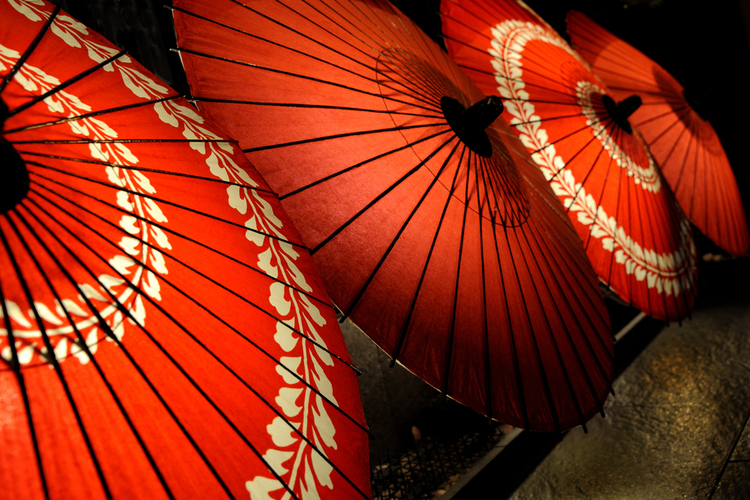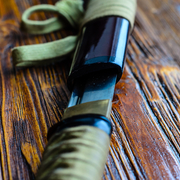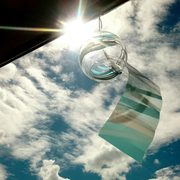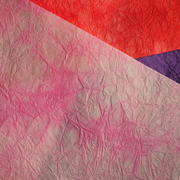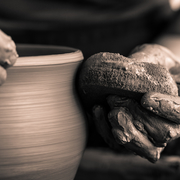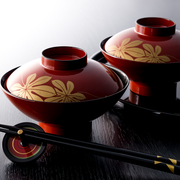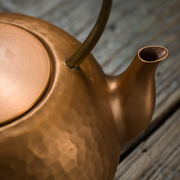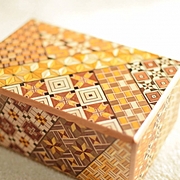This year, in 2018, to celebrate “Mt. Daisen 1300 years of History”, the dates of “the Parade of Torches-Wagasa Fantasy Nights-“, which is one of the traditional summer events in Kyoto, were extended to 10 days.
The path to Ogamiyama Shirine’s Okunomiya was illuminated by 120 Wagasa (Japanese traditional umbrella) with lighting which were designed as the landscapes of Sanin region, which created elegant atmosphere.
Also, at the events such as National Cultural Festival held in Nakatsu in Oita prefecture on 13th and 14th October, giant Wagasa in red with 8m in diameter and 5m high was displayed.
Since there are few craftsmen who inherited the techniques of Wagasa even in Japan today, giant Wagasa will act significantly to spread its traditional techniques.
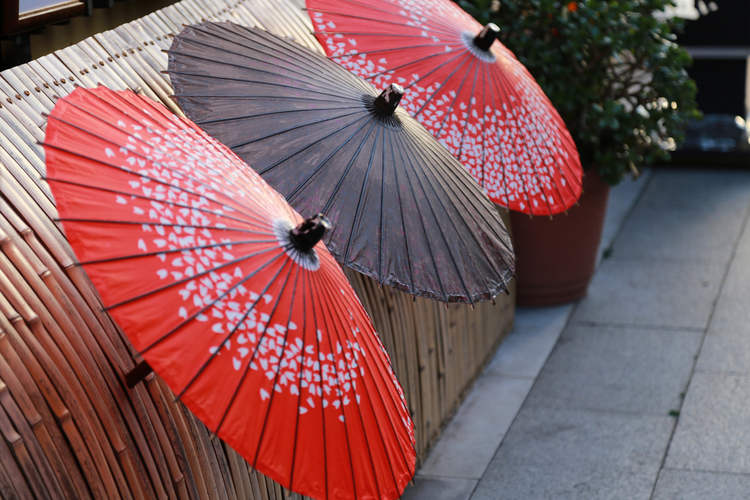
History of Wagasa
“Wagasa (Japanese traditional umbrella)” is the representative of traditional crafts in Japan, but it was not originated from Japan.
“Tengai”※1 which was used for sun-protect and a talisman by the nobles in China, was introduced to Japan and developed as rain gear that can be opened and closed for convenience.
※1Tengai: Covering pole stood on the ground without the function of opening and closing.
Tengai have an long history and was also said to be used as sun-protect for Buddha.
In Japan, since the Heian period(794-1185), Tengai was set and the servants started carrying it as a large-sized parasol for aristocrats.
In the Muromachi period(1136-1575), waterproofing with oils on Japanese paper made it to portable rain gear, which can be opened and closed.
It was in the Edo period(1603-1867) when ordinary people started using it.
After Western cultures were introduced to Japan in the Meiji period(1868-1912), the Western clothes spread among the upper class and umbrellas also became popular.
Then, Western clothes gradually spread among ordinary people. Especially, after the war, people’s wearing changed drastically from Japanese clothing to Western.
With those changes, Wagasa, which was widely used as the daily commodity, lost its position to the rare and special one which is only used as props of Japanese dancing and tea ceremony.
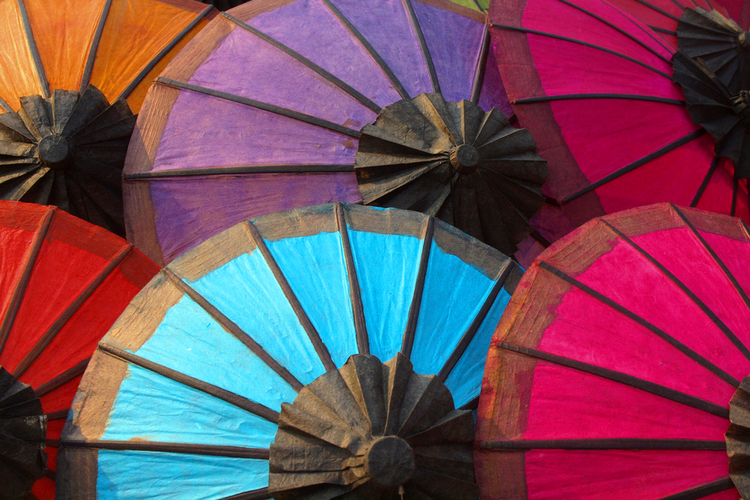
Recently, Japanese traditional culture and craftworks have attracted the attention, which made it use as special decoration at the gate of tea shops and restaurants serving traditional Japanese meals.
Craftsmen of Wagasa could be found across the country in the Edo period, but, since the Meiji period, the number has declined.
Today, there are a small number of craftsmen in Gifu, Kyoto, Kanazawa, Tottori, Tokushima and Oita.
Styles of Wagasa
Wagasa has 4 styles; Bangasa (sturdy umbrella), Janome-Gasa (slender umbrella), Higasa (sun parasol), and Maigasa (silk dance parasol).
Bangasa and Janome-Gasa use paper waterproofed by oil.
Wa-Higasa (Japanese parasol) is not waterproofed, so you can enjoy the original color of Washi (Japanese paper).
For Maigasa, not only Japanese paper, but cloth (silk) can be used, which is expensive.
B angasa (Sturdy umbrella)
Bangasa is one of Wagasa, born in the Edo period, which was used by ordinary people at that time. You may see them in period drama series.
It is very simple and sturdy umbrella with a bamboo-made handle and frame with plain Washi paper covering.
The size is for men, but both men and female used Bangasa.
The making process have often described in some scenes in TV programs and movies of period dramas, as side job of Ronin※2 living in Nagaya (row houses).
※2 Ronin: Masterless samurai, who wandered fleeing from registered area.
Janome-Gasa (Slender Umbrella)
Janome-Gasa is one of Wagasa, whose handle is slender.
It has elegant and gorgeous design.
Some grips are covered by wisterias, or that kind of decoration can be seen on Janome-Gasa.
Compared with Bangasa, the patterns of the exterior of Wagasa are more beautiful, which is one of the characteristics.
The name came from its dot patterns which look like Janome (bull’s eye, literally snake’s eye).
Putting decorated strings on Rokuro, which is a movable part of handle which connects the born to open and close, creates colorful looks of the inside of an umbrella.
Janome-Gasa is also used as props of Kabuki.
Today, its beauty of the pattern and decorated strings of Rokuro attract people to take it in a part of the interior decoration.
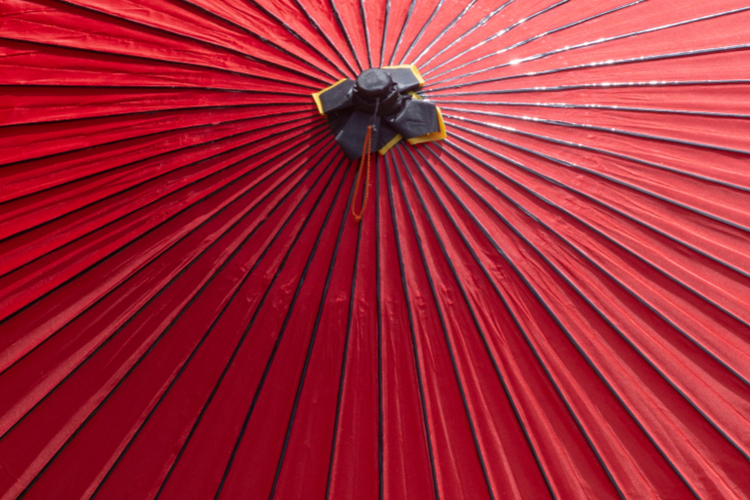
H igasa (Sun parasol)
Wa-Higasa (Japanese Sun parasol) is not waterproofed, so it does not work as rain gear.
It is not suitable for rain umbrella, but has great looks with original beauty of Washi itself and delicate patterns as it is not covered with water-proof oil.
Washi used on Wa-Higasa softens strong sunshine of summer as Shoji (a door, window or room divider with Washi over a frame) does.
You also enjoy the beauty of decorated strings of Rokuro.
Decorated strings are a part of design to amuse a person who opens Higasa.
M aigasa (Silk dance parasol)
Maigasa is mainly used for dancing.
Some are made from Washi, and expensive ones from pure silk.
Maigasa with pure silk has higher transparency and gorgeous looks.
Since it is used for dancing, it is designed to be simple enough to emphasize the beauty of dance as props without disturbing the pattern of Kimono.
As for decorated strings of Rokuro inside an umbrella, there are various patterns from very complicated to simple, but comparatively sober colors are commonly used.
You can use Maigasa as a sun parasol, but it is not suitable for an umbrella as it is not waterproofed.
Today, its elegant appearances are often taken in as a part of the interior decoration.
Right ways to use Wagasa
Although washi is very strong, it is to the extent of paper.
That is why water-proof with oil is necessary for Bangasa and Janome-Gasa to use as rain gear.
To maintain Washi for long, it is recommended to dry it longer on wet days like the rainy season.
When you close and carry Wagasa, you hold the head called “Kappa”, which is covered, having the handle down, unlike an umbrella.
Generally, holding “Kappa” prevents an umbrella from opening.
When an umbrella is soaking wet, your hands get wet by holding “Kappa”, but holding the head prevents rainwater come inside, where has no water-proof.
It is the right way to put Wagasa on the ground with a handle down and Kappa up.
It is important to note that this is the other way around for that of an umbrella.
Why has Wagasa disappeared from everyday life of Japanese?
Since people started not wearing Kimono by the effect of modernism in the Meiji period(1868-1912), Wagasa has lost its popularity as normal rain gear.
As a part of Taisyo Modernism※3 , there was the trend of blending of Japanese and Western styles, such as an umbrella on Kimono.
※3 Taisyo Modernism : The part of the Taisho period when unique culture harmonized the Japanese and Western, flourished with the development of rail transport, finance and merchandising after industrialization by civilization and enlightenment.
To make it worse, cheap Bangasa is heavy and is not as stylish as an umbrella.
Colorful Maigasa and Wa-Higasa are too expensive for ordinary people to use is as a daily commodity.
Also, although Washi is sturdy, Wagasa can be moth-eaten and is weaker resistant than a plastic umbrella.
Wagasa for ordinary people may be weak enough to end its work after one season only.
As time goes by, Western style clothes became ordinary in Japan, but unfortunately, Wagasa does not go with the Western.
In addition, the demand for cheap and handy umbrellas like a plastic umbrella has increased.
It may be inevitable that the popularity of Wagasa, which goes well with Kimono, faded away as the opportunities to wear Kimono on daily lives decreased.
As umbrella gear, your hands get wet by holding Kappa of Wagasa when it rains.
You put Wagasa on the ground with a handle down, which shows it prioritizes to maintain Wagasa itself more than convenience.
The reasons for the popularity of umbrellas lie in these issues like convenience, not only in the stylishness of modernism.
Also, as mentioned, as less people wear Kimono on ordinary days, Wagasa is used on less occasions.
Thus, as time goes by, the demand for Wagasa has declined, which led to the situation where the number of Wagasa craftsmen decreased.

Under the current trend, Japanese Wagasa craftsmen have challenged to preserve its tradition and successors in various ways.
For example, several different trials have been introduced such as small sized Wagasa as a part of decoration, giant Wagasa, lanterns and lamps made with the techniques of Wagasa.
It is a key to preserve the Wagasa culture, but at the same time, the techniques of Wagasa can be applied to the interior decoration, which has implied various possible opportunities.
Summary
Recently, cheap Wagasa have been mass-manufactured by machine for sale targeting foreign tourists.
However, some delicate details of Wagasa can be created only by craftsmen, which cannot be copied by machine.
There is a significant difference between the machine-made and the hand-made by Wagasa craftsmen.
Only the experienced handwork by craftsmen can create Wagasa as the fine-worked expensive interior decoration.
Not only the colorful pattern of Washi, but also the decorated strings of Rokuro inside Wagasa, are all finely made and beautiful.
We should preserve Japanese traditional culture by changing and improving its form, such as interior decorations and lamps in Japanese rooms for Wagasa.

